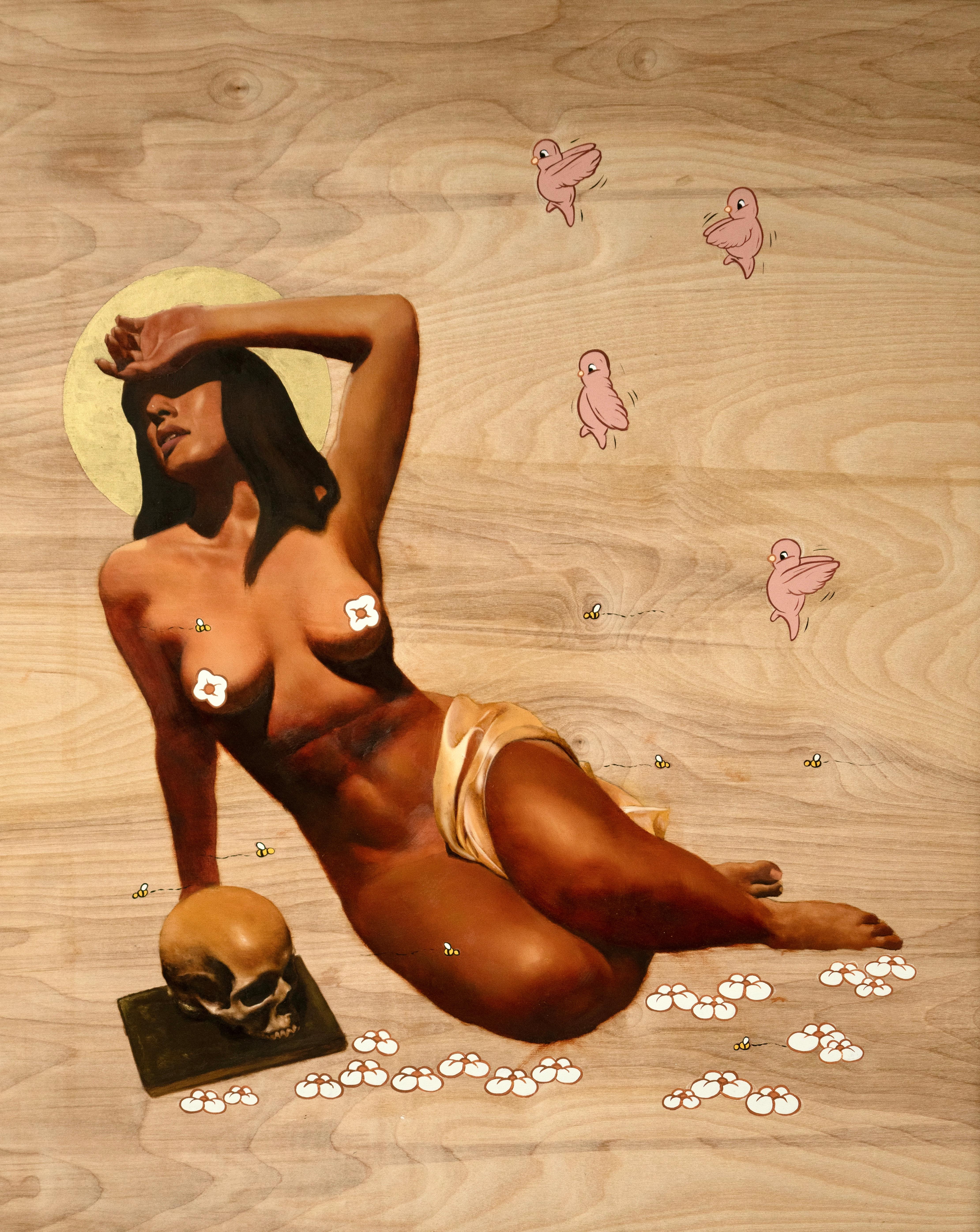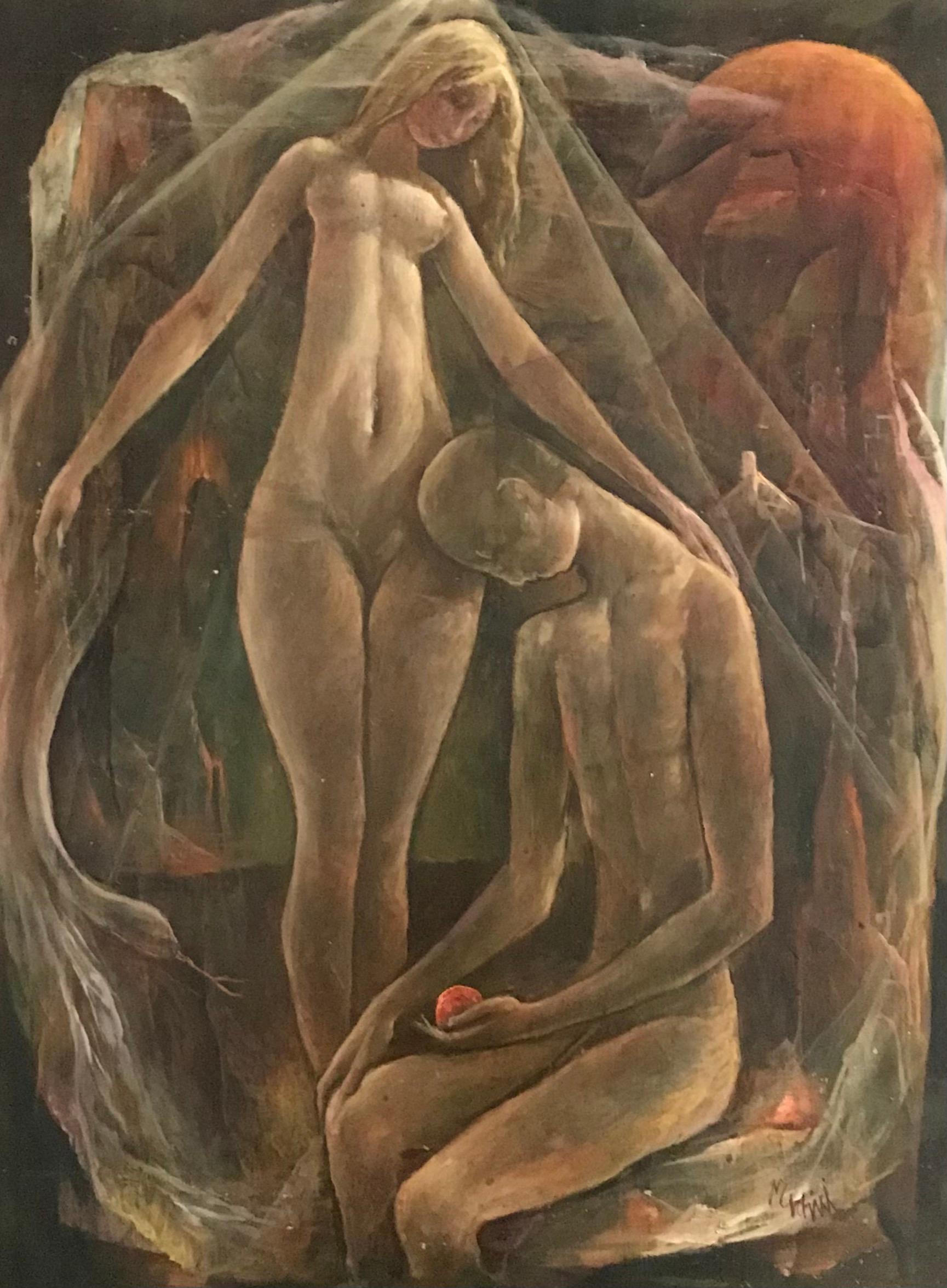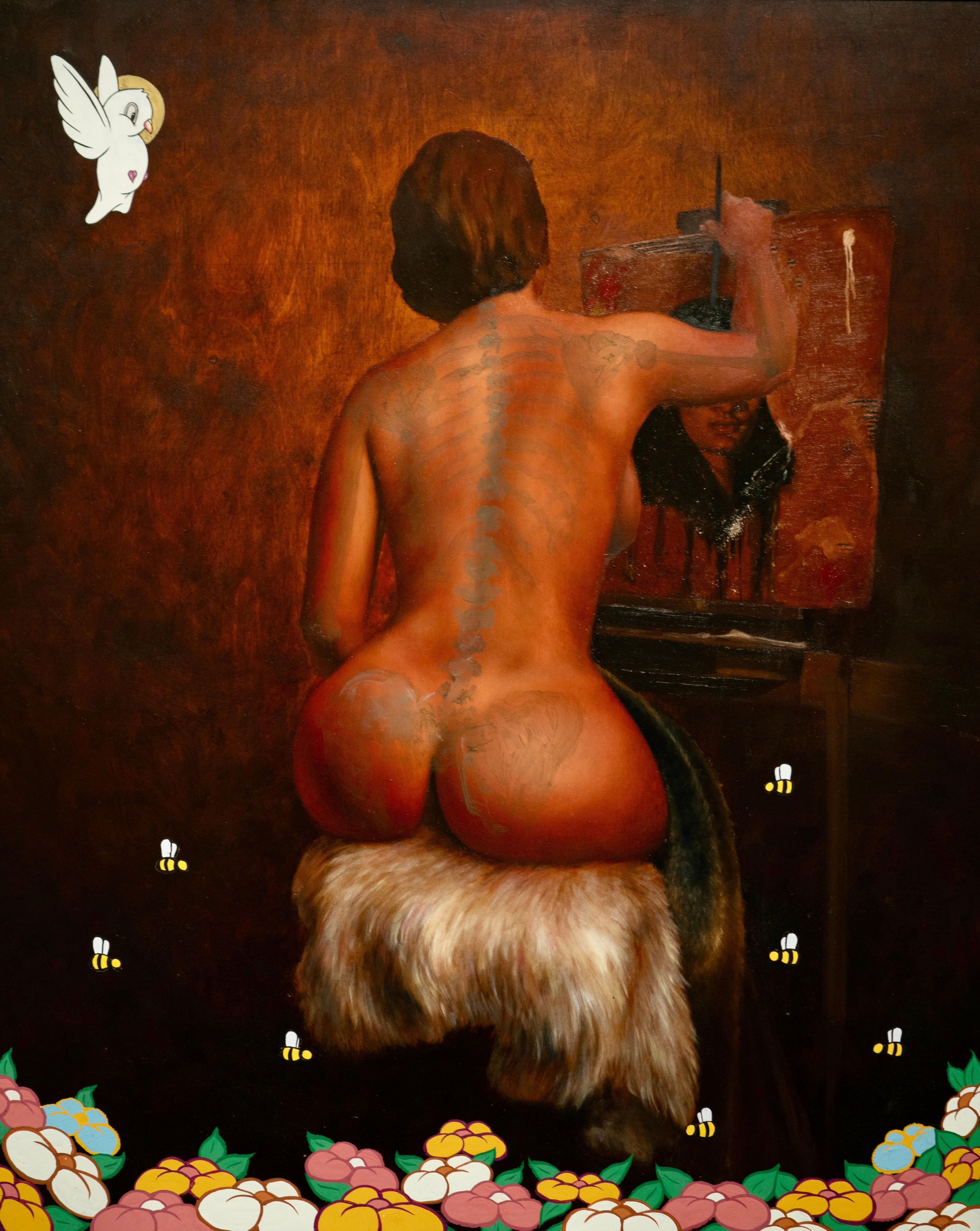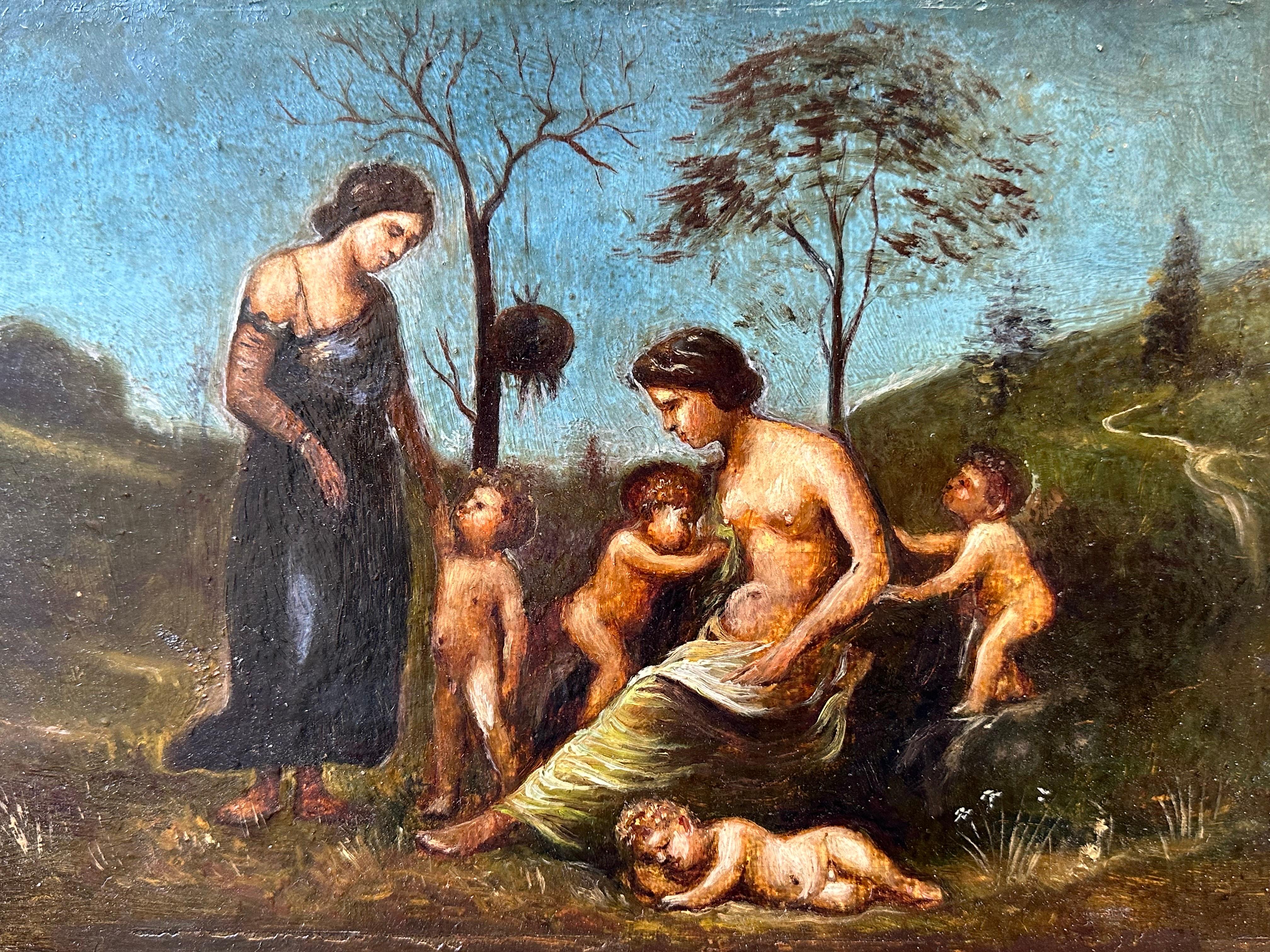Items Similar to Amor Cutting Bow, Parmigianino, Old Master, Mannerism, Prague, Large Painting
Want more images or videos?
Request additional images or videos from the seller
1 of 8
Amor Cutting Bow, Parmigianino, Old Master, Mannerism, Prague, Large Paintingc. 1610
c. 1610
About the Item
Already in the collection of Emperor Rudolf II in the first decade of the 17th century this composition was famous. The original is by Parmigianino and Rudolf's court painter Joseph Heintz the Elder made a copy after Parmigianino's Arch Carving Cupid, painted in 1535. These two paintings hung side by side for a long time in the imperial treasury in Vienna, where they were considered a special sight. Soon there were myths about the paintings, that Heintz had even died out of grief that his copy could never reach the artistry of the original.
The inspiration for this composition possibly goes back to a sculpture that Parmigianino might have seen in 1530 in the Grimani collection in Venice. In fact, Eros/Amor/Cupido stands before us like a painted sculpture. The subject probably goes back to late antique ideas in which Eros, Himeros (desire) and Pothos (longing) form an erotic triad. In the Renaissance it is redefined as heavenly and earthly love. This painting is thus a comment on the difficulty of choosing between these two forms of love.
The present painting is certainly connected to the composition by Heintz and it is another version of this subject by an so far unkown painter. The style clearly shows the influence of the Prague School. Its quality illustrates the style of Mannierism.
It is a very large, decorative piece and it creates a unique atmosphere in an interior.
Amor Cutting His Bow, 17th Century, Old Master, Mannierism, Rudolph II.
- Creation Year:c. 1610
- Dimensions:Height: 55.12 in (140 cm)Width: 34.26 in (87 cm)
- Medium:
- Movement & Style:
- Circle Of:Joseph Heintz (1564 - 1609, Swiss)
- Period:
- Condition:
- Gallery Location:Greven, DE
- Reference Number:1stDibs: LU155027942902
About the Seller
4.8
Gold Seller
These expertly vetted sellers are highly rated and consistently exceed customer expectations.
Established in 2011
1stDibs seller since 2021
20 sales on 1stDibs
Typical response time: 2 hours
- ShippingRetrieving quote...Ships From: Greven, Germany
- Return PolicyA return for this item may be initiated within 14 days of delivery.
More From This SellerView All
- Hercules and Omphale, Old Master Painting, Mannerism, Baroque, Mythology, PragueLocated in Greven, DEHercules and Omphale Oil on panel, 52 x 41 cm According to legend, Hercules had to make atonement and became a slave to the Lydian queen Omphale. When she found out who her slave was, she married him. Falling for his mistress and made effeminate by the luxury of court life, the former hero allowed himself to become the laughing stock of the court. He dressed in women's clothes, spun wool and did other women's work, whereas Omphale wore his lion's skin and carried a wooden club. When the time of punishment was over, the hero realised his delusion and left Omphale. So far, the painting could not be clearly assigned to an artist. Nevertheless, it impresses with its fluid and convincing painting, whose colourfulness and conception are reminiscent of the Prague School around Bartholomäus Spranger. This work follows an engraving and an etching made by Michel Dorigny in 1643 after a design by Simon Vouet. It shows the same scene but the print differs in minor details from the present painting (see e.g. the head of the lion) and the treatment of the faces seems to be painted more detailed and refined. So far there is no painting...Category
17th Century Baroque Figurative Paintings
MaterialsOil, Panel
- Rococo Painting, The Brunette Odalisque, Nude Woman, Studio of Francois BoucherBy François BoucherLocated in Greven, DEA voluptuous woman lies prone on a divan, bearing her backside and turning her head flirtatiously to the viewer, though averting her eyes slightly, as if to maintain a coy demeanor. Surrounded by lush fabrics of deep blues, the creamy tones of her skin and dressing gown are thrown in sharp contrast, making the figure glow luminously. The whole painting is ordered by folds - of flesh, of fabric, of cushions, of the rug - inviting the viewer's eye to look closely across the topography of the canvas. One of Boucher's cabinet paintings (that is, paintings made for private collectors rather than official exhibition at the Salon), the open eroticism of this work invites a voyeuristic gaze. Although it was created for a private audience, it was later displayed at the Salon of 1767, where the critic Denis Diderot found it shocking and lascivious. Nonetheless, Boucher would later paint another iteration of this reclining pose, this time using Marie-Louise O'Murphy, a favorite mistress of King Louis XV, as his model, suggesting that the provocative composition was a stock figure for Boucher's private commissions. "The Brunette Odalisque" (French: L'Odalisque or l'Odalisque brune) is a painting of c. 1745 by François Boucher, now in the Louvre in Paris. He later produced two other works in the odalisque genre, both known as "The Blonde Odalisque". The present painting is another version of Bouchers painting which differs in minor details. The quality of the paint is very fine and the whole technique and style allows a dating to c. 1750. As Boucher's Painting was very famous there were several copies and versions which were made by his studio. The present painting can be attributed to the close circle of Boucher. The Painting is framed in a golden frame which was built in the Rococo style in c. 1990. Both the title of Boucher's painting and the objects found in the interior fix the subject as an odalisque, a concubine within the harem of the Ottoman sultan. The sumptuous textiles and exotic, decorative objects suggest early traces of Orientalism, although the figure appears European. Odalisque paintings...Category
18th Century Rococo Nude Paintings
MaterialsCanvas, Oil
- Fenzoni, Painting AND preparatorial Drawing, John the Baptist, Italy RenaissanceBy Ferrau FenzoniLocated in Greven, DEThe painting and the preparatory drawing are offered together. Provenance Private collection, Germany, Trier, c. 1980- 2013 Saint John the Baptist Brown ink and wash over red chalk on oatmeal paper 31 x 20.5 cm Inscribed: „Ferrau Fenzonio da Faenza invt. esque … imp. da Fran. Villamena …“. bears the collector's mark of Henry Scipio Reitlinger (1882-1950; Lugt 2274a) on a tiny label glued to the verso On the reverse is a partial drawing of a Pieta, pricked for transfer. Provenance New York, Doyle, 14. October 2015, No. 6 The painting and the preparatory drawing resemble the composition of an engraving after Ferraù Fenzoni by Francesco Villamena. Drawing, engraving and painting are almost identical, except for minor differences. Even the measurements nearly correspond: painting (32 x 25,5 cm), drawing (30 x 20,5 cm), engraving (31,1 x 23,5 cm). Dr. Guiseppe Scavizzi confirmed the attribution of the present panting to Fenzoni and he dates it to c. 1590. The inscription on the drawing reads “Ferrau Fenzonio da Faenza invt. esque. . . imp. da Fran: Villamena . . .”. The engraving’s inscription also lists place and date “Ferra Fensionius inventor/F. Villamoena sculpsit Rome/Aspectu fruitur… antra puer/cum Privilegio… 1613”. Interestingly, the engraving is not mirrored as it is in most printing processes. Painting, drawing and engraving are not reversed but the same. It is remarkable to note that there are further paintings by Fenzoni which were engraved in the same order and not reverted. They also show strong parallels regarding the compositions and the measurements (see for example “Deposition of Christ” ). Ferraù Fenzoni was an Italian painter mainly active in Todi. He is also called Il Faenzone after his birthplace (Faenza). He apprenticed in Rome during the papacy of Gregory XIII and contributed to numerous fresco cycles under pope Sixtus V, such as the Loggia della Benedizioni in the Lateran Palace, the frescoes on the walls and vaults of the Scala Santa of the adjacent Basilica of San Giovanni in Laterano, and the decoration in the Sistine library. His expressive canvases straddle the styles of Mannerism and Baroque. In 1594, he moved to Todi. A “Last Judgement” by him is housed in the cathedral of Todi. He returned to Faenza in 1599, where he decorated chapels in the cathedral from 1612 to 1616. In 1622, he completed a “Deposition”, now in the local Pinacoteca. In 1640, Fenzoni was named “cavaliere dello speron d’oro” by Cardinal Colonna and, on 25th April 1634, he was nominated vicar and “castellano of Granarolo”. Fenzoni‘s style is characterized by a mixture of the Mannerism of the Northern Netherlands and the Italian Baroque. Saint John the Baptist, Old Master, 17th Century, By Fenzoni, Religious Scene, Rome Art...Category
16th Century Mannerist Figurative Paintings
MaterialsCanvas, Oil, Handmade Paper
- Portrait of a Boy, John Closterman, Large English Portrait Art, Old MasterBy John ClostermanLocated in Greven, DEJohn Clostermann (Osnabrück 1660 - 1711 London) Portrait of a boy, maybe Charles Hinde Oil on canvas, 61 x 74,6 cm John Closterman (also Klosterman) was a portrait painter of the late 17th and early 18th centuries. He primarily portrayed English noblemen and European aristocratic families. His father was already an artist and he trained his son. In 1679 he went to Paris and studied with Francois de Troy. In 1681 he was in London and worked for the artist John Riley, whose studio he took over after his death. In 1696 he was invited to the Spanish court...Category
17th Century Baroque Figurative Paintings
MaterialsCanvas, Oil
- Soldiers by a Tent, Soldiers Camp, Circle Van Huchtenburg, Old Master PaintingBy Jan van HuchtenburgLocated in Greven, DECircle of Jan van Huchtenburg Landscape Scene with a Soldiers Camp Oil on Canvas, 41 x 55 cm Soldier Camp Life Scene together with a wonderful golden FrameCategory
18th Century Baroque Landscape Paintings
MaterialsOil, Canvas
- Saint Bartholomew, Old Master, Oil Print, Ribera, Figurative Art, Spanish ArtBy Jusepe de RiberaLocated in Greven, DEOld Master An Oil Print after a Painting by Jusepe de Ribera in the Museo del Prado, Spain. This is an early print after the original.Category
20th Century Baroque Figurative Prints
MaterialsOil, Canvas
You May Also Like
- Late 18th Century Italian Baroque Allegorical Mythical Nudes “Virtue of Vice”Located in Rancho Santa Fe, CAThis painting is likely to be from the late 18th or early 19th century, and is seemingly inspired by Antonio Correggio's "Virtue of Vice" circa 1531. Frame dimensions: 30 x 49 inches. This painting has been in a private California collection for over 40 years. It was acquired from a high end antique...Category
19th Century Baroque Nude Paintings
MaterialsCanvas, Oil
- "HARMONY" Painting (FRAMED) 30" x 24" inch by Isaac PelayoBy Isaac PelayoLocated in Culver City, CA"HARMONY" Painting (FRAMED) 30" x 24" inch by Isaac Pelayo Medium: oil and acrylic on wood Comes in frame Size framed: 32" x 26" inch ABOUT THE ARTIST: Isaac Pelayo is a head on ...Category
21st Century and Contemporary Baroque Figurative Paintings
MaterialsWood, Oil, Acrylic
- The snake and the apple by Vivaldo Martini - Oil on canvas 50x65 cmBy Vivaldo MartiniLocated in Geneva, CHHis first name sounds like a concerto. Vivacious, its name is reminiscent of an aperitif or a cyclist. The addition of the two evokes the Italianate. Indomitable and unavoidable. Mor...Category
Mid-20th Century Baroque Nude Paintings
MaterialsOil
- "SARAH" Painting (FRAMED) 30" x 24" inch by Isaac PelayoBy Isaac PelayoLocated in Culver City, CA"SARAH" Painting (FRAMED) 30" x 24" inch by Isaac Pelayo Medium: oil and acrylic on wood Comes in frame Size framed: 32" x 26" inch ABOUT THE ARTIST: Isaac Pelayo is a head on crash collision between The Renaissance and Street Art. In a household where constant turmoil and violence were more apparent than most a young Pelayo met escape and peace within the confines of himself and his own creativity. Hispanic born in the heavy beating heart of Los Angeles on the seventh day of June 1996. Pelayo was caught in the crossfires of everything that surrounded him but art served as his only guidance. After dropping out of college Pelayo turned from his hyperrealistic pencil portraits to oil painting where his passions grew more immensely. As of today Pelayo’s work is most influenced and fueled by the crème de la crème of old master painters like Da Vinci, Caravaggio, Rembrandt, and Velazquez as well as graffiti artists such as RETNA, Shepard Fairey, and EL MAC. In 2017 his work caught the attention and landed in the firm grasp of renown rapper and collector Alvin “Westside Gunn” Worthy. He has created several album covers and artworks for the Buffalo rap moguls music label Griselda Records including his personal collection. Pelayo’s paintings are widely recognized and sought out from all over the globe. His collectors include Sean “Diddy” Combs, Westside Gunn, Benny The Butcher, Jeff Hamilton, Shepard Fairey, Jaysse Lopez, and Everlast of House of Pain...Category
21st Century and Contemporary Baroque Figurative Paintings
MaterialsOil, Wood, Acrylic
- Very Fine 18th Century Italian Oil Painting Nude Figures in Classical LandscapeLocated in Cirencester, GloucestershireClassical Figures in Ancient Landscape Italian School, 18th century oil on panel, painting: 9 x 12 inches provenance: private collection, Paris condition: very good and sound conditionCategory
18th Century Baroque Figurative Paintings
MaterialsOil
- Valentine Love (Number 10 White), Figurative Art, Valentines Gift, Classical ArtBy Agent XLocated in Deddington, GBValentine Love (number 10 white) R’ depicts silhouette of a Valentine. As snipped from the pure white background, Agent X creates the illusion of a cut-out to reveal a Baroque, flora...Category
21st Century and Contemporary Baroque Nude Paintings
MaterialsPaper, Giclée





